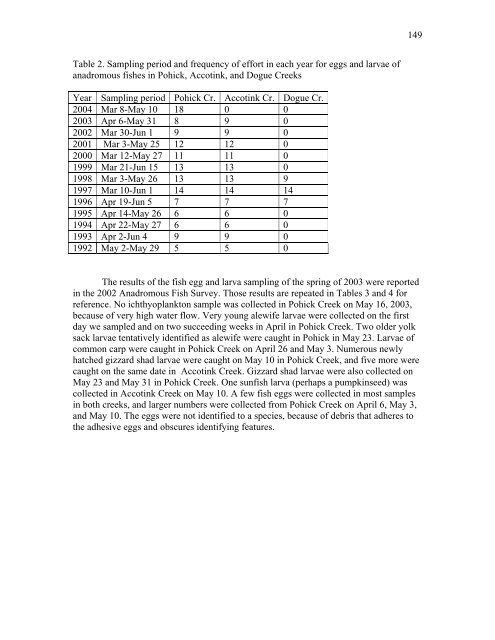NEW: Annual Report - George Mason University
NEW: Annual Report - George Mason University
NEW: Annual Report - George Mason University
Create successful ePaper yourself
Turn your PDF publications into a flip-book with our unique Google optimized e-Paper software.
Table 2. Sampling period and frequency of effort in each year for eggs and larvae of<br />
anadromous fishes in Pohick, Accotink, and Dogue Creeks<br />
Year Sampling period Pohick Cr. Accotink Cr. Dogue Cr.<br />
2004 Mar 8-May 10 18 0 0<br />
2003 Apr 6-May 31 8 9 0<br />
2002 Mar 30-Jun 1 9 9 0<br />
2001 Mar 3-May 25 12 12 0<br />
2000 Mar 12-May 27 11 11 0<br />
1999 Mar 21-Jun 15 13 13 0<br />
1998 Mar 3-May 26 13 13 9<br />
1997 Mar 10-Jun 1 14 14 14<br />
1996 Apr 19-Jun 5 7 7 7<br />
1995 Apr 14-May 26 6 6 0<br />
1994 Apr 22-May 27 6 6 0<br />
1993 Apr 2-Jun 4 9 9 0<br />
1992 May 2-May 29 5 5 0<br />
The results of the fish egg and larva sampling of the spring of 2003 were reported<br />
in the 2002 Anadromous Fish Survey. Those results are repeated in Tables 3 and 4 for<br />
reference. No ichthyoplankton sample was collected in Pohick Creek on May 16, 2003,<br />
because of very high water flow. Very young alewife larvae were collected on the first<br />
day we sampled and on two succeeding weeks in April in Pohick Creek. Two older yolk<br />
sack larvae tentatively identified as alewife were caught in Pohick in May 23. Larvae of<br />
common carp were caught in Pohick Creek on April 26 and May 3. Numerous newly<br />
hatched gizzard shad larvae were caught on May 10 in Pohick Creek, and five more were<br />
caught on the same date in Accotink Creek. Gizzard shad larvae were also collected on<br />
May 23 and May 31 in Pohick Creek. One sunfish larva (perhaps a pumpkinseed) was<br />
collected in Accotink Creek on May 10. A few fish eggs were collected in most samples<br />
in both creeks, and larger numbers were collected from Pohick Creek on April 6, May 3,<br />
and May 10. The eggs were not identified to a species, because of debris that adheres to<br />
the adhesive eggs and obscures identifying features.<br />
149
















